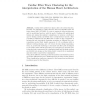Free Online Productivity Tools
i2Speak
i2Symbol
i2OCR
iTex2Img
iWeb2Print
iWeb2Shot
i2Type
iPdf2Split
iPdf2Merge
i2Bopomofo
i2Arabic
i2Style
i2Image
i2PDF
iLatex2Rtf
Sci2ools
FIMH
2009
Springer
2009
Springer
Cardiac Fibre Trace Clustering for the Interpretation of the Human Heart Architecture
Cardiac fibre architecture plays a key role in heart function. Recently, the estimation of fibre structure has been simplified with diffusion tensor MRI (DT-MRI). In order to assess the heart architecture and its underlying function, with the goal of dealing with pathological tissues and easing inter-patient comparisons, we propose a methodology for finding cardiac myofibrille trace correspondences across a fibre population obtained from DT-MRI data. It relies on the comparison of geometrical and topological clustering operating on different fibre representation modes (fixed length sequences of 3-D coordinates with or without ordering strategy, and 9-D vectors for trace shape approximation). In geometrical clustering (or k-means) each fibre path is assigned to the cluster with nearest barycenter. In topological (or spectral) clustering the data is represented by a similarity graph and the graph vertices are divided into groups so that intra-cluster connectivity is maximized a...
Cardiac fibre Architecture | FIMH 2009 | Heart Architecture | Medical Imaging | fibre Representation Modes |
| Added | 26 May 2010 |
| Updated | 26 May 2010 |
| Type | Conference |
| Year | 2009 |
| Where | FIMH |
| Authors | Carole Frindel, Marc C. Robini, Joël Schaerer, Pierre Croisille, Yue-Min Zhu |
Comments (0)

